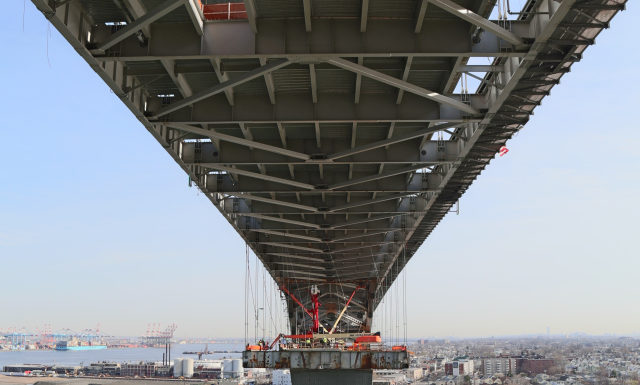This article was originally presented as “Unbuilding the Bayonne Bridge” by Neal Buccino, posted at the The Port Authority of New York and New Jersey’s Portfolio blog.
The Bayonne Bridge “Raise the Roadway” project was designed to lift the span of the Bayonne Bridge to accommodate a new generation of bigger commercial ships. This effort posed an unprecedented engineering challenge: building a new bridge over the old roadway, while the existing one was still open and carrying traffic.
The work is progressing well. Recently, the U.S. Coast Guard Sector New York and pilot organizations lifted air draft restrictions enabling vessels carrying up to 9,800 TEUs to call terminals west of the Bayonne Bridge without worrying about tidal conditions.
Soon, the newly raised roadway will provide a clearance of 215 feet – the same air draft as the Verrazano Narrows Bridge – allowing ships with up to 18,000 TEUs to pass below to access terminals located in New Jersey and Staten Island.
With this major milestone accomplished, “Raise the Roadway” engineers are focused no on ‘unbuilding’ the old bridge.
With the Port Authority’s close supervision, and the dedication of scores of demolition workers and engineers, the removal of the Bayonne Bridge’s original span is taking place at record speed. The old bridge took 38 months to build, and carried traffic for 85 years. According to the most recent estimates, dismantling the old roadway will take four months or six months ahead of schedule.
The colossal task of removing 9,800 tons of aged steel and concrete – and doing it safely, above an active waterway without polluting the environment – is performed section by section, from the center of the span, out to each terminus of its historic arch.
A container vessel passes beneath the Bayonne Bridge while workers continue removing steel from its lower roadway. Photo by Mike Dombrowski, Port Authority.
The entire process takes place at dizzying speed as shown in this time lapse video prepared by the Port Authority’s Raphael Azucar and Conrad Barclay: https://youtu.be/lkM1MisRpwA.
The span is divided into sections called “panel points,” each of which represents a concrete square — 40 feet on a side — supported by steel girders and floor beams, and suspended by two wrist-thick steel ropes that support both the original and the newly built roadway from the bridge’s iconic steel arch.
To remove the structure, cranes equipped with giant saws slice each panel point into four 20-foot concrete squares. The squares are then lifted away, revealing the steel framework that held them in place for nearly a century. Workers then remove the metal box of girders and floor beams, and proceed to the next panel to start the process again.
The material removed was placed mostly on trucks and driven out over the remaining roadway. As the bridge span now is almost entirely gone, however, it needs to be lowered onto a barge on the Kill van Kull. The remaining steel will be recycled. One day, some of it may well be reincarnated as the bones of a new bridge.
Sparks fly as workers separate the 85-year-old steel floor beams and girders that once made up the lower span of the Bayonne Bridge. Photo by Mike Dombrowski, Port Authority.
The “Raise the Roadway” project’s expected economic benefits – not to mention the challenge of building a new roadway 215 feet above the Kill van Kull, 64 feet above the original span– make it one of the most unique infrastructure projects in the United States. Navigational clearance is expected this summer.
“I’m pleased that we are reaching navigational clearance six months ahead of schedule,” said Steven Plate, the Port Authority’s Chief of Major Capital Projects. “I am also extremely proud of what we have accomplished through the drive and dedication of the men and women who are performing this critical work.”



